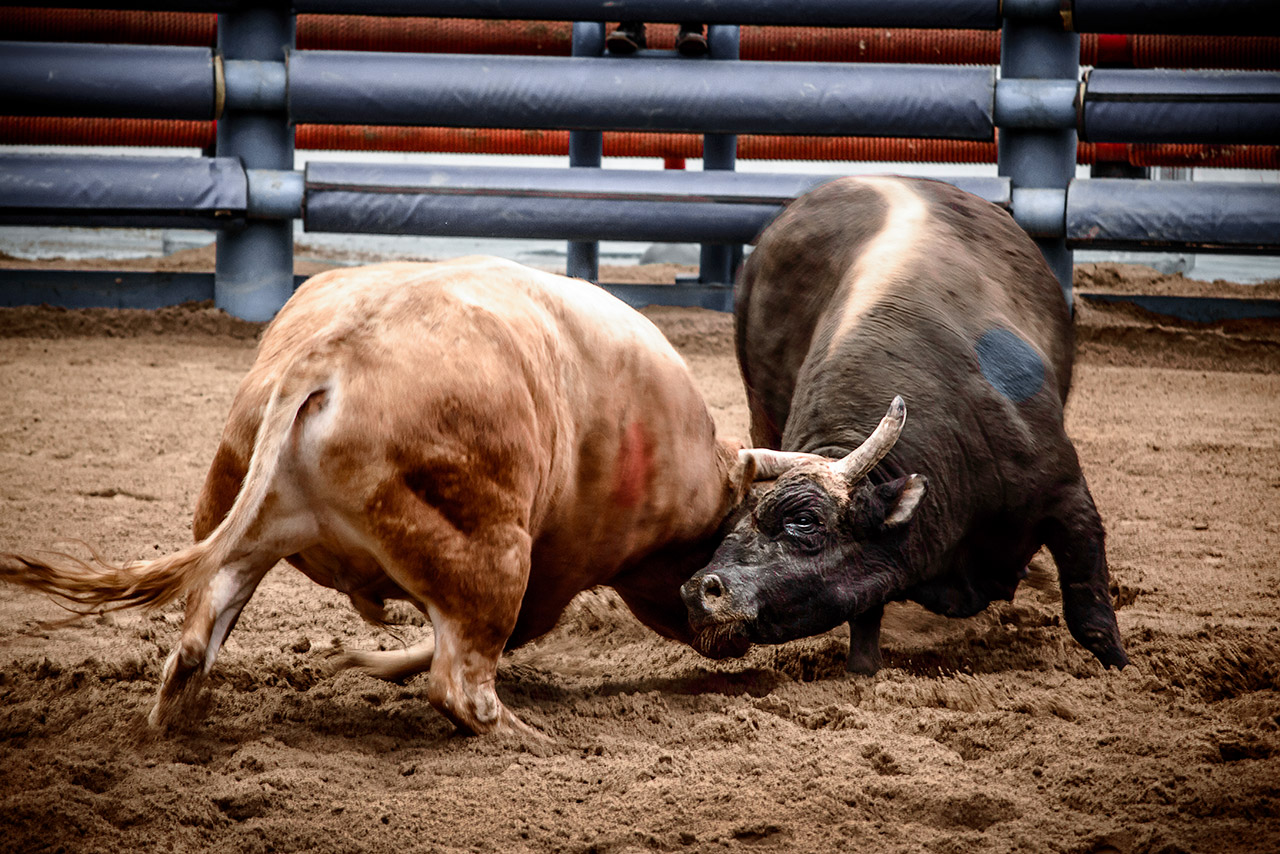
Betting slips clutched in hand, a frenzied crowd roars as the helpless anticipation consumes the arena. Spectators marvel as metric tonnes of muscle collide, the clash of horns and the clatter of skulls audible over the boisterous din. No gore. No sword. No matador. In South Korea, the conflict is an entirely bull-on-bull affair. Sand shifts as grimacing faces are buried beneath the loose matter under-hoof. They heave. They twist. They froth whilst gasping at the dusty air, encouraging trainers edging perilously closer to the marauding monsters – the sweet prospect of substantial prize negating all regard for harm-to-self. 5 minutes. Twenty. An hour. The struggle endures for as long as is required for the dauntlessness to diminish such that the feeblest foe scarpers from the skirmish, the conqueror bellowing his bovine battle cry. Rushing back to he bookkeepers, sore losers endeavour to recover loss, and victors seek to build upon their earnings. In a matter of minutes, the crowd shall be granted fresh contest…
The sport of bullfighting on this eastern peninsula is a far cry from its crueller, non-Korean counterpart; you’ll find no ornately-clad Iberians brandishing blades here. The animals fight exactly as they would in the wild. And whilst to some this still remains a touch brutal, it has far more akin to boxing than it does a true bloodsport, and the suffered fate is undeniably more humane than is sentenced by a matador. It’s a much less barbaric spectacle altogether, with the great brutes simply turning tail once they fear defeat. In fact, beyond bloodied horns and scalps, the bulls are rarely harmed. Rather, it is predominantly pride that risks injury. Trainers are described as having a real affinity with their animals – perhaps a vestige of bygone years where bulls stood a farmer’s most prized of possessions. The beasts are fed on the finest of diets, vigilantly schooled, run kilometres each day and are conditioned into the lean specimens we see led into the bullring. A caring pat on the back from loving master and a rumoured dutch-courage soju shot precurse commencement of competition.
All but forgotten amidst blistering modernisation, Korean bullfighting can be experienced at only a handful of venues hidden in far-flung corners of the peninsula, and is a must for anyone looking to experience remnants of a none-too-distant agrarian past. The jewel in the cow-combat crown is undoubtedly Cheongdo. Since its inception in 1999, Cheongdo Bullfighting Festival (held mid-April) has matured into the pinnacle championship among trainers, and has drawn over half a million visitors to date. Cheongdo is a small, otherwise non-descript town nestled in the rolling hillside of Gyeongsangbuk-do, and is the fabled birthplace of the 1,000-year-old tradition. Most easily accessed from Daegu, the Mugunghwa or “slow train,” running between Seoul and Busan will deliver you to your destination. Those wishing to hurry matters along somewhat are advised to take a KTX to Dong-Daegu, connecting with the Mugunghwa there, wherefrom the journey is but a short hop (27 minutes, ₩2,600). For bookings or for information on KTX services, click here. Those with a mind on their finances will wish to catch bus #7 from opposite the station entrance, though buses are rather less-regular in this neck of the woods. If you’re not so keen on waiting around, grab a taxi from the station parking lot, mime a raging bull to your driver, and you’ll be at the arena within 10 minutes around ₩6,000 lighter. If charades lets you down, jot this down and hand it to your cabbie: 청도 소싸움축제.
Unless strawberry picking and sampling a persimmon wine falling in taste between feline urine and a bitter vinaigrette are your thing, it isn’t necessary to arrive early – Cheongdo has very little to recommend save the arena. The first of the 1,000 kilo powerhouses lock horns around midday; it remains perfectly possible to soak up the carnival atmosphere arriving mid-afternoon, as most tour groups tend to. The Daegu Compass is your best source of tour group information. Those who fancy a flutter can take advantage of more relaxed gambling laws that accompany this festival. Bulls are marked red and blue for convenience. If you’re not the pot-luck sort, grab a form guide for information on the weight of the bulls (the bigger bull won almost every single bout in 2013), as well as the number of wins, draws, and losses this season. I lost every single bet placed before consulting the form guide, and won every one afterwards – so it’s worth seeking out if you plan to wager. You can bet on a multitude of things including the duration of each bout; I stuck simply to outright winner (odds fixed at 1/5). The guide is written entirely in Korean (would you expect otherwise?), but as ever in this great land, English speaking staff are at hand to help you make vague sense of it all.





